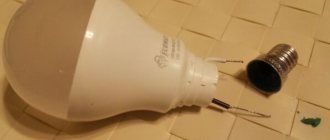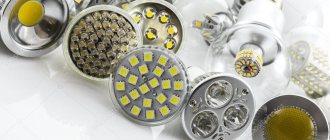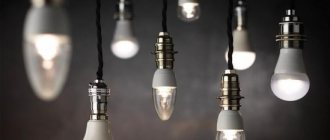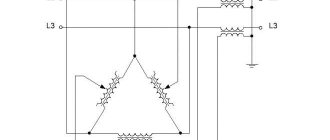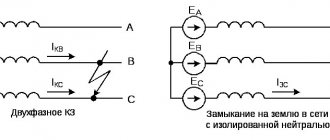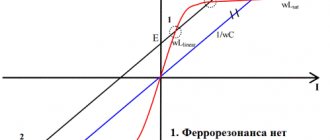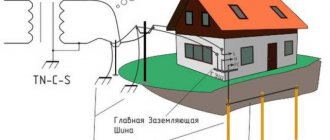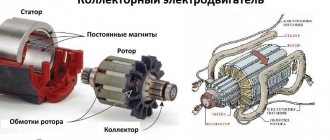Edison base e27
The base ensures fastening in the lamp socket thanks to a screw thread. The thread type is designated by the letter “E”. The number below indicates the diameter in millimeters. E27 is most common in Europe and Russia. Historically, it was developed by Thomas Edison specifically for incandescent lamps. Patented in 1894.
Design
Edison base design
The base is a cylinder with a diameter of 27 mm with a thread. The body is made of aluminum. At the top there is a bottom contact. One of the electrodes leading to the tungsten helix is attached to the bottom. The second electrode is connected to the thread. In addition, in the base of incandescent and halogen lamps there is a glass insulator. The insulator inside is hollow, air is pumped out through it, inert gases and halogen vapors are added to the “halogens”.
When connecting, the phase wire should be connected to the contact of the base. The neutral wire is connected to the screw thread . With such a connection, the likelihood of a person being exposed to current is minimal.
Connecting E27 to the electrical network
The design of the bases for other types of light sources is the same, with the exception of the glass insulator. For some LEDs, it may contain a driver.
Filament LED Light Source
Dimensions
E27 has standard sizes.
Dimensions e27
Types of lamps with e27 base
Incandescent lamp
Historically, the first developed version of light sources. E27 was developed specifically for this type, so other types of bases are rarely used in their design. The power is in the range of 15-250 W, the luminous flux is the smallest - approximately 10 lm/W.
The advantages include low price, simplicity and reliability of design, stable glow in difficult operating conditions: high humidity, low temperatures. Good quality of light: smooth, not pulsating.
On the other hand, incandescent lamps have little service life and consume the maximum amount of energy. Because of the glass bulb, they are very fragile and become very hot when illuminated.
Energy saving [CFL]
Compact fluorescent lamps (CFLs) have replaced incandescent lamps. CFLs differ from ordinary direct fluorescent lamps in their shape: the tube with mercury vapor is rolled into a spiral to reduce overall dimensions. High luminous flux: 50-70 lm/W.
The advantages of fluorescent light sources include low electricity consumption and a long service life.
Among the disadvantages, there is a danger to human health due to the presence of mercury vapor; need for special disposal. To operate at the rated power level, it takes some time to warm up. CFLs do not work well at low temperatures (less than +5⁰); Below -15⁰ they are not allowed to be used at all. The quality of their glow depends on the stability of the network voltage and the number of on-off cycles. High price.
Halogen
They are designed like incandescent lamps, only halogen vapors are added to the bulb. This leads to an increase in operating time and light output: 17-20 lm/W. E27 is not the most common type for halogens. Type g is most often used.
Among the advantages of the light source, one can note the ability to glow in difficult operating conditions: at low temperatures, high humidity. Low price, good quality light.
The disadvantages include the dependence of operation on the stability of the voltage in the network, high energy consumption and operating features: it is forbidden to touch the halogen lamps with hands without gloves - this causes rapid failure due to fingerprints on the bulb.
LED
The youngest type of light sources. They are characterized by the highest light output (80-120 lm/W) and the longest operating period. LED lamps with E27 are designed to replace incandescent lamps.
Among the advantages are a stable glow under difficult operating conditions, a wide range of color temperatures, the ability to work with a damaged bulb, and high energy efficiency. Some models have dimming capabilities.
The disadvantages of LED lamps include high price and dependence on the stability of the mains voltage. Low voltage models (12, 24 V) require additional equipment. Also, due to the degradation of LEDs, the brightness decreases towards the end of their service life.
Comparative characteristics of all types of light sources are given in the table. (For comparison, lamps with an equal luminous flux of 1200 lm were used).
| Comparison parameter | Light source type | |||
| Incandescent lamp | "Halogen" | CFL | LED | |
| Power, W | 100 | 50-70 | 25-30 | 12-15 |
| Service life•, h | 1000 | 2000-4000 | 10000-15000 | 20000-50000 |
| Color temperature, K | 2400-3000 | 2700-3000 | 2700-6000 | 2800-6500 |
| Price | Low | Average | Above average | High |
| Disposal | Regular | Separate from ordinary glass | Only at special collection points | Regular |
| Environmental Safety | Safe | Safe | Very dangerous | Safe |
| Electricity consumption | Maximum | High | Small | Minimum |
| Dependence of operation on voltage drops | Eat | Eat | Eat | Eat |
| Low temperature dependence | Absent | Absent | Present | Absent |
| Dependence on high humidity | Absent | Absent | Present | Absent |
- — the service life declared by the manufacturer is given when operating under ideal conditions.
Powerful new generation LED lamps
Powerful LED lamps have appeared, in which the phosphor is applied to the bulb from the inside. I studied and tested new generation lamps.
Conventional LED bulbs use white LEDs, or COBs, in which the blue-emitting LEDs are coated with a chemical called a phosphor, which turns blue light into white.
In Uniel Profi lamps, the phosphor is applied not to the LEDs, but to the lamp bulb. This technology has several advantages:
- the phosphor does not fade from heat and the lamps last much longer without changing color characteristics;
- lamps have higher efficiency.
The disadvantage of the technology is that much more phosphor is required, and it is not cheap.
Uniel Profi lamps are designed for lighting production facilities, warehouses, and other facilities where powerful light sources are required.
I tested all four Uniel Profi series lamps:
LED-MP200-50W-4000K-E27-PH ALP06WH - 50 W, 6500 lm, E27 base, color temperature 4000K; LED-MP200-50W-6000K-E27-PH ALP06WH - 50 W, 6500 lm, E27 base, color temperature 6000K; LED-MP200-80W-4000K-E40-PH ALP06WH - 80 W, 10000 lm, E40 base, color temperature 4000K; LED-MP200-80W-6000K-E40-PH ALP06WH - 80 W, 10000 lm, E40 base, color temperature 6000K.
An ordinary incandescent lamp in the photo will help you appreciate the impressive size of powerful lamps.
Luminous flux, color temperature and color rendering index were measured using a two-meter integrating sphere and an Instrument Systems CAS 140 CT spectrometer, power consumption and power factor were measured with a GW Instek GPM-8212 device, pulsation with an Uprtek MK350D device. Before measurements, to stabilize the parameters, the lamps were warmed up for half an hour.
Results of measuring the parameters of 80-watt lamps.
Despite the fact that the actual power (75.1 and 76.3 W) turned out to be slightly lower than declared, the luminous flux was higher than declared - 10695 and 10715 lm. The lamps have very high efficiency - 142.4 and 140.4 lm/W.
Results of measuring the parameters of 50-watt lamps.
The actual power is slightly less than the declared one - 45.4 and 45.7 W, the measured luminous flux was also slightly less than the declared one - 6244 and 6296 lm, but it is only 3-4% less, which is quite acceptable. Efficiency 137.5 and 137.8 W.
For industrial use, it is very important that the power factor (also known as power factor, also known as cosine phi) is high. For 80-watt lamps it is 0.97, for 50-watt lamps it is 0.95. These are excellent results.
There is practically no pulsation of light (for 50-watt lamps the ripple coefficient is less than 0.3%, for 80-watt lamps it is about 1%).
The color rendering index CRI(Ra) is 72.1-72.5. This is enough for industrial premises, where according to standards Ra should be above 70 (let me remind you that for home lighting Ra more than 80 is desirable).
In the manufacturer’s online store, 50-watt lamps cost 2,805 rubles, 80-watt lamps cost 4,127 rubles.
Thanks to the use of remote phosphor technology, Uniel Profi lamps have high efficiency and greater durability compared to conventional LED lamps. The manufacturer claims a service life of 35,000 hours (four years of continuous operation) and, unlike most household lamps, these are very real figures. Moreover, it is quite possible that lamps of this design will last much longer.
© 2022, Alexey Nadezhin
How to disassemble an e27 LED lamp
Disassembling an LED light source is not difficult even for a novice electrical engineer. The main thing is to arm yourself with the necessary tools.
LED design
You will need an awl, a syringe with a needle and a solvent (for paints; not acetone). Pour the solvent into the syringe. Carefully run an awl along the edge of the diffuser in the place where it is attached to the radiator. Pour solvent little by little from the syringe into the well. Wait 5 minutes: during this time, the solvent will soften the sealant that glues the diffuser. Then carefully rotate the diffuser and remove it.
If the diffuser is not glued to anything, then simply twist it and remove it.
If the diffuser is attached with latches, then with an awl, moving around the circle, it is enough to pry up the diffuser and find the places of the latches. After this, you can easily bend them with an awl (or a sharp knife) and remove the diffuser.
After removing the diffuser, all that remains is to unscrew the screws from the board with LEDs with a screwdriver, remove the board and remove the driver. If there are no screws, then the board is glued with sealant. It is enough to cut it with an awl around the circumference and remove the board by prying it with a knife.
What is a 100W LED Bulb?
Best Color Quality: GE Reveal 100W Replacement Bright Stik LED
| Replacement Cree 100W LED | Replacement LED GE 100W | |
| Brightness (lumens) | 1,606 (1,650 claimed) | 1,604 (1,600 claimed) |
| Power consumption (in watts) | 16.5 | 15 |
| Efficiency (lumens per watt) | 97.3 | 106.9 |
| Colorful temperature | 2,700 K | 2,700 K |
Using Base Adapters
If you bought a chandelier with a base size that is different from the light bulbs you have, it doesn’t matter. Numerous adapters are produced that allow you to combine different sizes and even types of bases.
Adapter from E14 to E27
Adapter from e27 to g9
However, this approach may deteriorate the appearance of the lamp. After all, with the adapter, the light source will protrude more strongly from the lampshade. When purchasing, pay attention to the adapter sizes. For example, the approximate length of the first adapter is 6.6 cm; the second – 3.9 mm. With an adapter, the light bulb may simply not fit into the small lampshade.
